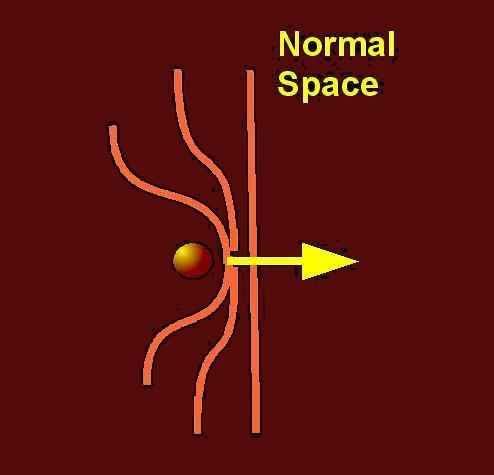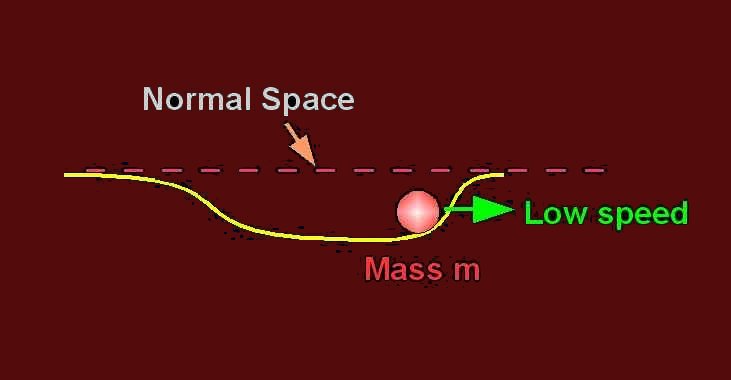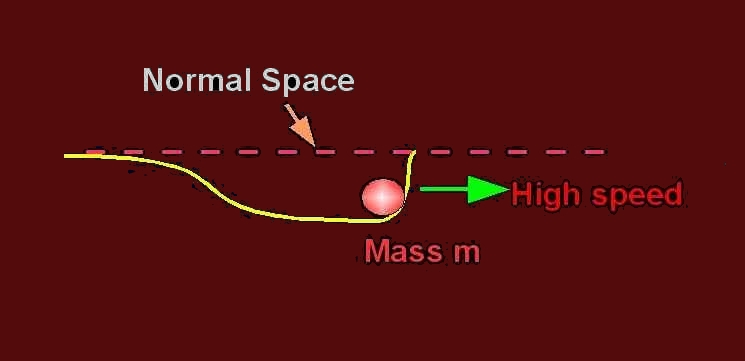Einstein's Relativity Outlined
According to Einstein's relativity theory, when we travel faster (relative to an observer), distance l and time t become dilated for the traveller? Ultimately, according to Einstein, the result being that if we could reach the speed of light c, we could travel to any part of the universe in zero time. Of course, this is not physically possible because as our speed v also increases our mass m, becoming infinitely large at the speed of light.
These three phenomena are classically defined by the following of Einstein's equations for relativity:
l
= lo
t
= to
m
= mo / Where lo,
to
and mo
are the values at zero relative velocity.
Where lo,
to
and mo
are the values at zero relative velocity.
The speed of light is obviously the kingpin of all these equations that determines the limits. This leads me to wonder why the speed of light defines the limit to these relative changes and what, in fact, decides the speed of light? Also, why is the traveller's viewpoint different to the observer's? Length and time become smaller (i.e. dilated) as speed increases, while mass becomes greater.
Compression Theory

My spatial (and temporal) compression theory confirms and supports Einstein's relativity equations and explains why approaching the velocity of light (and all EM waves) create this dilation effect and increases mass. Before proceeding with my compression theory, it is necessary to establish an understanding of the speed of light and create a definition for 'normal' space. The compression theory is based on the understanding that, as Einstein also proposed, space is a geometric structure. A little imagination is required to visualise geometric space as defined by contour lines similar to those used for survey maps. Thus 'Normal' space could be considered as the volume of space where there were no strong gravitational forces and the contour lines would be evenly spaced.
What would define this normal space geometry? I believe that this would be defined by the total mass and 'inpansion' of the universe, because space (and time) is created by the relative movement and subsequent separation of matter (discussed later). Of course there will be variations in the geometry, but the average of these variations will still be normal space, because the universal mass would be constant and will always tend to recover the geometry back to normal density (the normal space could be compared to the still surface of a pond and variations being ripples that slowly decay back to this surface). Since normal space (on average) defines the movement of objects through it, it follows that the movement of an object through normal space will be effected by it and vice versa. I believe that a moving object compresses the spatial density in front (see diagram above) and that, as the object's speed increases, the geometric density increases until normal space cannot be recovered, and that this is the limit imposed by the speed of light.
NOTE: The compression of space does not assume that space has physical attributes but helps an understanding of the behaviour and interaction between matter and energy. One theory that I discovered suggested that space behaves like a fluid (as proposed by Henry H. Lindner - Fluid Space). Fluid mechanics and formulae are well established and could be useful in calculating some of the spatial compression effects. I am not convinced about space having physical fluid attributes, but his fluid theory has similar thoughts (I suppose that my spatial compression theory could be considered as the 'dry' space version!)
The implication is that the speed of light is determined by the mass of the universe and the rate of inpansion of the universe. The outcome of this suggests that for a constant speed of light, the universe would have to be finite, constantly expanding and retain a constant mass. This also supports the big bang theory. However, if the rate of expansion changes, then the speed of light could also change.
Compression Details

This
means that a mass's
gravity is not a force but the effect of a geometric 'dip' in that
region of space caused by the mass (as proposed by Einstein).
However, although this dip is symmetrical for a stationary mass, if
the mass was moving at a relative velocity, the spatial geometry
becomes more and more compressed as its velocity increases
(see diagram). (This effect can be considered as analogous to the bow
and
stern wave on a boat).

Spatial Compression at Sub-Light Velocity - 2D Linear Representation*
The reason I think is that as the mass's velocity increases, the spatial structure requires a time to recover and this recovery time T becomes more difficult as the speed of light is approached.
The resultant spatial compression curve thus becomes steeper and steeper as the speed of light is approached, until it becomes vertical at the speed of light (see diagram below) creating an the effect of an infinite gravity pull at the front (i.e. making the mass appear infinite, as in Einstein's equation).

Spatial Compression at Speed of Light - 2D Linear Representation*
However, the compression is maximum in front of the mass, but, because of recovery time, the spatial geometry is 'stretched' behind the mass creating a negative gravity distortion. This is analogous to the bow and stern wave produced by a boat. The overall effect is that the mass had no combined velocity effect outside the spatial distortion, thus retaining the stability of the surrounding regions. Time is also affected in a similar manner (described later). This supports Einstein's dilation effects because the observed view will be distorted spatially and temporally from behind the mass creating a different time and space.
Measurable Effects of Spatial Compression

Measurable Effects of Spatial Compression
Two stars passing each other within their distorted fields would be more likely to be attracted to each other because of the variation of spatial compression between the bow and stern and therefore more likely to become double stars because of the difference between the bow and stern spatial density; a phenomena observed in recent years. (A similar effect can observed by small boats passing close by to each other, especially in shallow water.)Comets would have two tails, one due to solar wind and the other due to the tail wave behind the comet travelling at high velocity (but dependent on the comet's relative speed to the solar system).
In a
galaxy, the high
velocity of the outer arms creates an effective large mass at the bow
of the arm mass direction thus creating a gravitational effect which
could could be mistaken as dark matter. In addition to this, the
compression front will attract stars in front, while the decompressed
rear will repel stars, thus creating the spiral arms.
Einstein's Relativity - Mathematics of Recovery
If
spatial compression is
an explanation of motion through space, then it may be necessary
to make some modifications to Einstein's theory. For example,
although the compression wave at the bow would follow Einstein's
equations
for spatial and temporal dilations (and increasing mass) with speed,
the spatial compression geometry around the mass has a graded effect
resulting in a possible negative effect in the tail.
At the
bow front the Recovery Quotient R would
be proportional to the ratio of v and c and can be defined by using the
common v/c function from Einstein's dilation equations:
R =
If you substitute the recovery quotient into Einstein's dilation equations at the start of this section, then length, time and mass changes are dictated by the same Recovery Quotient R.
If you study the Dilation Diagram, Einstein proposed that as you approach the Speed of Light v/c -> 1 causing time and distance to dilate to zero. In terms of temporal and spatial compression, this would be true for the traveller (s) because the geometry of time space in front is compressed to zero. However, the geometry behind has a stretched effect which causes observers (t) at the point of origin to see a different viewpoint because their space and time remains unchanged and the stretched geometry has little effect on their local time and space.

Dilation Effect
Therefore, if the traveller returns near the SOL say a 10 years later, the observers will have aged 10 years and the traveller will still be the same age (assuming the unlikely instant acceleration of the traveller for demonstration purposes).
If the compression effect fades to the rear, the recovery effect will also change. The mathematics for this effect is still being investigated.
Why Mass Increases With Speed
What is mass or matter? Electrons orbit a nucleus at velocity v and distance d.
Hence v is proportional to d/t.
According
to Einstein (using the recovery quotient):
d=do.R and t=to.R
therefore orbit speed remains constant while d reduces with speed of
atom through space. This makes the atom smaller and denser, i.e. the
size decreases but the mass increases. The electron energy levels
should also change because the electron orbit is reduced.
Temporal Compression
Temporal
compression has been mentioned as being similar to spatial
compression. This section is aimed at my thinking behind this.
Whereas space can be created by the separation of matter, so time is
also created by the same process, i.e. time is just the effect of
matter moving and changing. The reason is based on the logic
that movement can only occur during a time interval and that the
overall universe is continuously inspanding creating time and space.
The universe exists
across space and time because they are both interdependent. You cannot
separate the them because they are both determined by the geometry of
space. We only see a snapshot of
the universe at a given point in time, so we tend to think of it as it
is now, but because the universe exists across all time and space, we
will never know its true existance. We have invented time to measure
change and length dimensions to measure the volume of space but,
although we define these as our 4 dimensions for our calculation
purposes, they are all just part of a single spatial geometric
dimension. This topic of Universal Dimensions
will be discussed later because it requires a detailed explanation. As
an example, a car travelling at 100km/h can be calculated by measuring
the distance it travels in one hour but what is really happening is
that it is compressing space and time relative to its surroundings. The
density of the compression represents our concept of speed which we
have broken into measurable elements to simplify our calculations.
Einstein's Relativity - Mathematics of Recovery
Speed of Light
Space and Matter
As described in the Spatial Compression section, as an object moves through space, so a compression wave is set up in front which become increasingly compressed as the speed increases, see the 2-dimensional diagram below.

Fig 7.1 Compression of Space at Speed of Light`
The compression of space also involves a Recovery time determined by the surrounding matter and resulting gravitational fields. At the speed of light, the spatial compression is unable to recover fast enough behind the moving mass, thus the speed of the mass is limited, but is, in effect, passing through normal space at an infinite speed and will take zero time to travel anywhere in the universe (as Einstein predicts in his theory of relativity - as shown in the Expanding Universe section - i.e. the separation theory).
In fact, the recovery time is not only determined by the surrounding matter but also by the total mass of the universe. This is because (as described in the Expanding Universe section) Normal space is created by the matter expanding and creating our universe.
The Recovery time will also determine the speed of light (and other electro-magnetic energy waves) simply because they have a measurable mass and are also affected by the Recovery time.
The effect of this deduction is that the speed of light will be different in another universe if the mass of the universe is different, but will also be affected by the expansion. This speed difference may be the case between our universe and a parallel universe.
V=C*M*E
Where C is a constant, M is mass of universe, E is expansion rate of universe